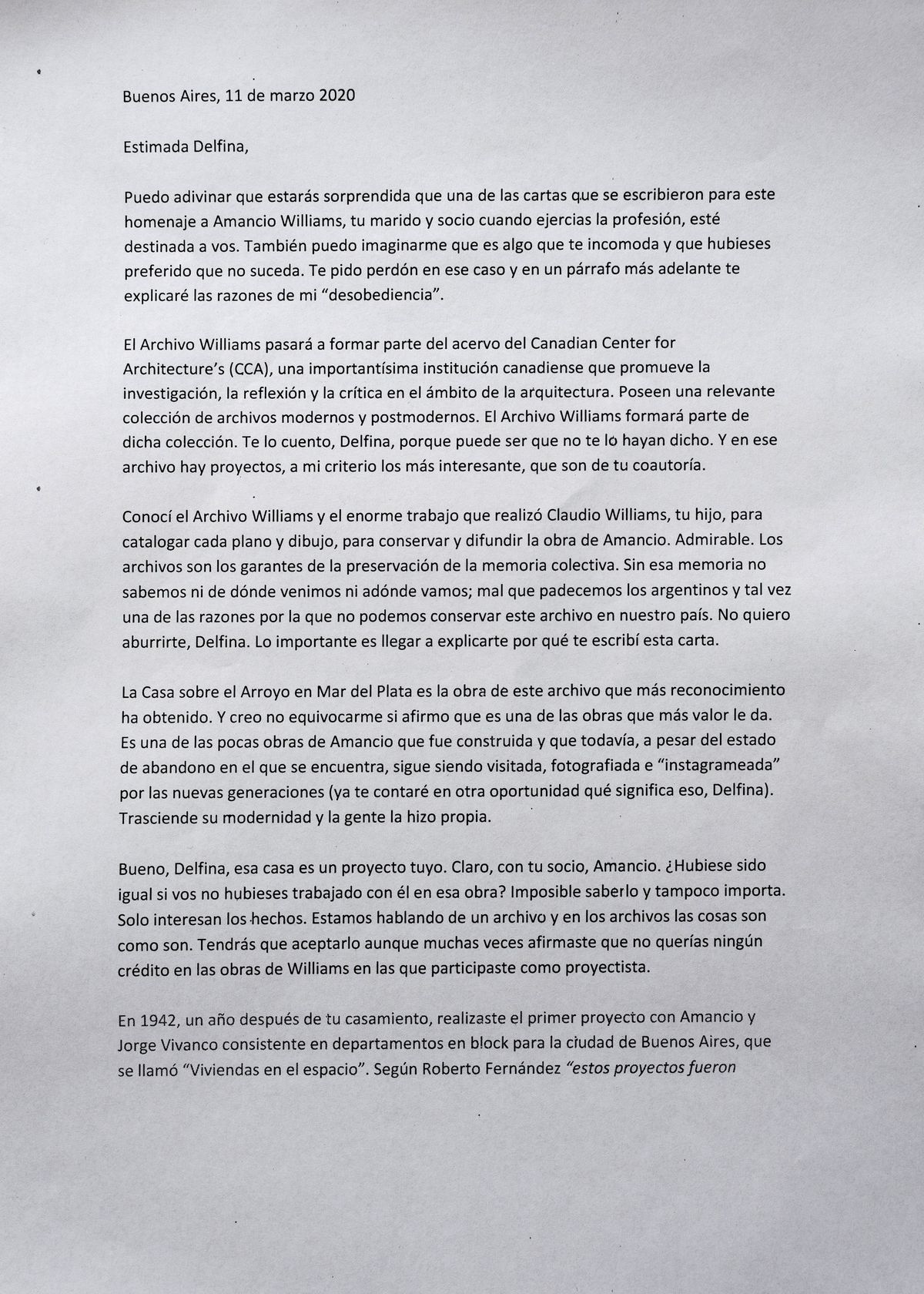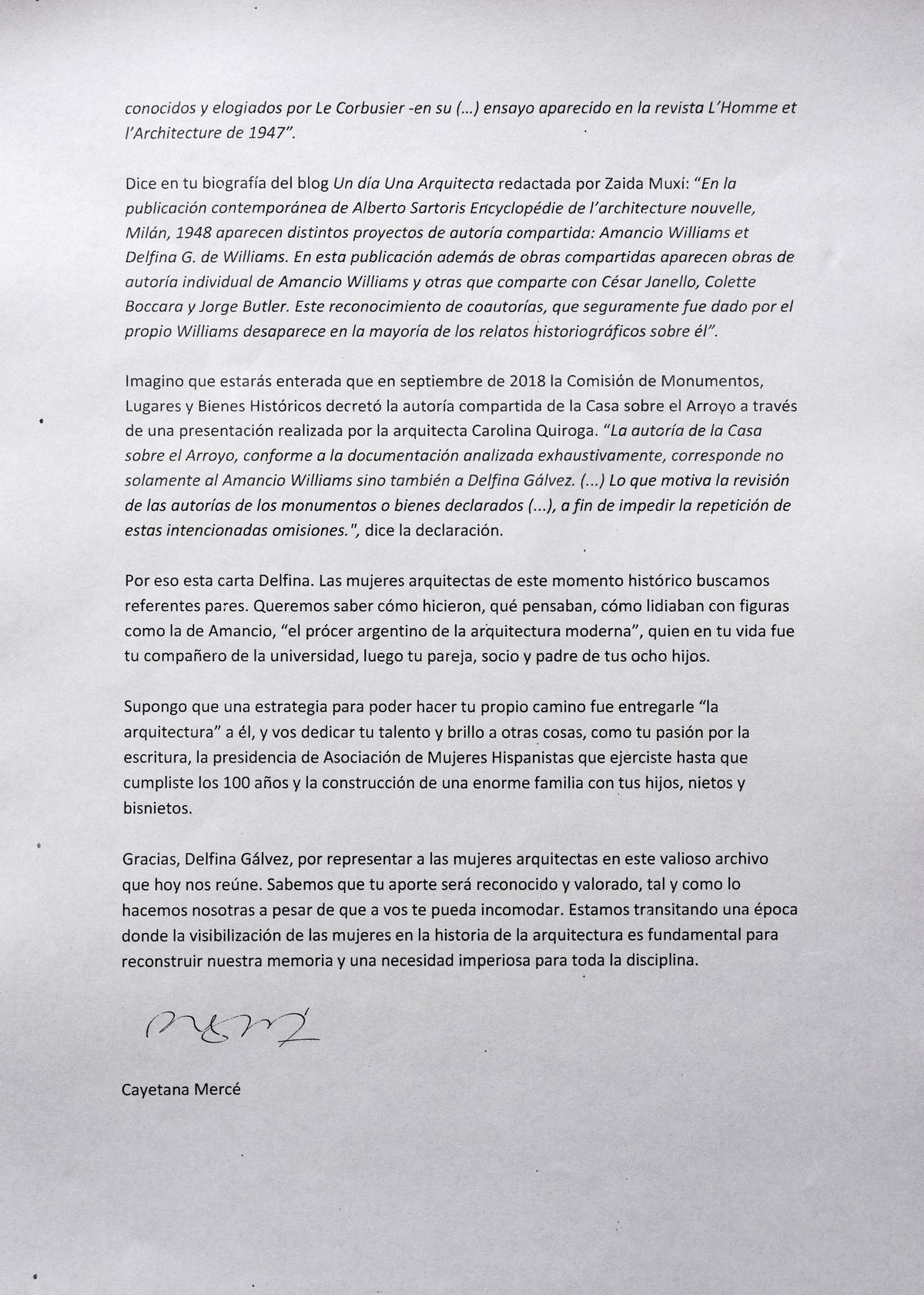I guess you’ll be surprised to learn that one of the letters written for this tribute to Amancio Williams, your husband and partner when you were in practice, is addressed to you. I can also imagine that it makes you uncomfortable and that you would have preferred it not to happen. In that case, I apologise, and later in this letter I will explain the reasons for my “disobedience.”
The Williams Archive will be part of the collection of the Canadian Centre for Architecture (CCA), a leading institution that promotes research, reflection, and criticism in the field of architecture. It has an outstanding collection of modern and postmodern archives, of which the Williams Archive will be part. I’m explaining this to you, Delfina, because you might not have been told. And because in this archive there are projects—the most interesting ones, in my opinion—that you co-authored.
I’ve seen the Williams Archive and the tremendous work that Claudio Williams, your son, did to catalogue every plan and drawing, to preserve and disseminate Amancio’s work. Admirable. Archives safeguard the preservation of collective memory. Without this memory, we know neither where we’ve come from nor where we are going—something we Argentinians often suffer from and perhaps one of the reasons this archive cannot be kept in our country. I don’t want to bore you, Delfina. What’s important is that I explain to you exactly why I’m writing this letter.
The Casa sobre el Arroyo in Mar del Plata is the most recognized work in the archive. And I think I’m not mistaken in saying that it’s one of the works that makes the archive so valuable. It is one of the few works by Amancio to be built and, despite its abandoned state, continues to be visited, photographed, and “instagrammed” by new generations (I’ll explain what this means at some other moment, Delfina). It transcends its modernity, and people make it their own.
Well, Delfina, that house is a project of yours. Together with your partner, Amancio, of course. Would it have been the same if you hadn’t worked with him on it? Impossible to know, and it doesn’t matter. Only the facts matter. We are talking about an archive, and in archives things are the way they are. You’ll have to accept it, even though you’ve often said you wanted no credit for the works by Williams in which you participated as a designer.
In 1942, a year after your marriage, you developed the first project with Amancio and Jorge Vivanco, an apartment building for the city of Buenos Aires called “Houses in Space.” According to Roberto Fernández, “these projects were known and praised by Le Corbusier—in his […] essay published in the journal L’Homme et l’Architecture in 1947.″
Your biography on Zaida Muxí’s blog, Un Día una Arquitecta, says: “In Alberto Sartoris’ publication from the same time, Encyclopédie de l’architecture nouvelle (Milan, 1948), different projects appear with shared authorship by ‘Amancio Williams et Delfina G. de Williams.’ Along with these joint works, the publication includes individual works by Amancio Williams and others shared with César Janello, Colette Boccara de Janello, and Jorge Butler. This recognition of co-authorship, which Williams himself probably supplied, disappears in most of the historiographical accounts about him.”
I imagine you know that in September 2018 the Commission of Historical Monuments, Places and Properties acknowledged the shared authorship of the Casa sobre el Arroyo in a presentation given by the architect Carolina Quiroga. The statement reads: “The authorship of the Casa sobre el Arroyo, according to thoroughly analysed documentation, corresponds not only to Amancio Williams but also to Delfina Gálvez. […] This occasions a review of the authorship of listed monuments or properties […] in order to prevent the repetition of these intentional omissions.”
Hence this letter, Delfina. We, contemporary women architects, are looking for peer references. We want to know what you did, what you thought, how you dealt with figures like Amancio, “the Argentinian hero of modern architecture,” who, in your life, was your fellow student, then your companion, partner, and father of your eight children.
I guess one strategy for you to make your own way was to leave “architecture” to him and to devote your talent and brilliance to other things, like your passion for writing, the presidency of the Association of Hispanic Women, which you held until your one-hundredth birthday, and the construction of a huge family with children, grandchildren, and great-grandchildren.
Thank you, Delfina Gálvez, for representing women architects in the valuable archive that brings us together today. We know that your contribution will be recognised and valued, just as we recognise and value it, even though it might make you uncomfortable. We live at a time when the visibility of women in architectural history is vital to the reconstruction of our memory and imperative to the discipline as a whole.
Cayetana Mercé
Buenos Aires, 11 March 2020

